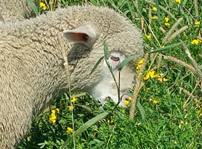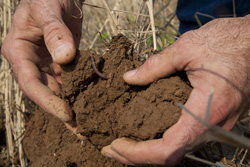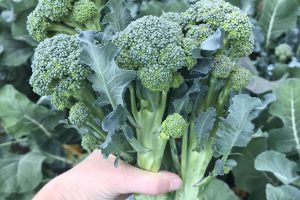 “Montebello” green variety of sprouting broccoli harvested from the NNYADP mini-brassica crops research trial at the Willsboro Research Farm on May 23, 2021. Photo: Elisabeth Hodgdon
“Montebello” green variety of sprouting broccoli harvested from the NNYADP mini-brassica crops research trial at the Willsboro Research Farm on May 23, 2021. Photo: Elisabeth Hodgdon
Plattsburgh, N.Y.; June 30, 2021. The Northern New York Agricultural Development Program (NNYADP) has awarded a grant for trials of early spring high tunnel miniature cabbages and sprouting broccoli crops. These cold-tolerant brassica (cruciferous) crops have the potential to fill the sales gap that occurs between when winter storage crops are sold out and before spring field crop harvest begins in New York State’s northern region. The research team, which includes vegetable production specialists with Cornell Cooperative Extension and the Willsboro Research Farm, harvested its first miniature versions of these vegetables in May 2021.
The opportunity to produce miniature varieties of broccoli and cabbages that are quick-growing and able to grow in unheated high tunnels will help northern New York growers respond to the unprecedented surge in demand for local foods spurred by the COVID-19 pandemic.
“In 2020, wholesale buyers sought out more sprouting broccoli than the market could supply through the northern New York food hubs,” said Elisabeth Hodgdon, Ph.D., a regional vegetable specialist with Cornell Cooperative Extension’s Eastern New York Commercial Horticulture Program.
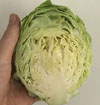
Hodgdon is overseeing trials of fall-overwintered and early spring-planted high tunnel-grown varieties of sprouting broccoli and mini-cabbages for harvest in April and May. The research will collect data on planting dates, crop establishment, growth patterns, and yield.
Sprouting broccoli is commonly grown in Europe. Growers harvest small heads of the broccoli in various colors on long stalks, which can be cooked similarly to asparagus. The miniature cabbages offer growers a fresh green crop to sell well before field cabbage is ready for fresh market sales. The mini-cabbages have tender green leaves that are excellent for salads.
Cornell Cooperative Extension Regional Agricultural Business Specialist Lindsey Pashow is working with regional growers on ways to package, price, and prepare these vegetable crops for wholesale and retail markets. Pashow and Hodgdon are also helping growers develop food safety plans and implement practices to meet Food Safety Modernization Act and Good Agricultural Practices requirements.
An additional aspect of this Northern New York Agricultural Development Program-funded regional vegetable project is focused on how to plant cold-tolerant brassica species as field cover crops to enhance soil health and to help suppress pests, weeds, and crop diseases. The researchers will examine different varieties and planting date effects on forage radish and mustard biomass production before killing frosts arrive in northern New York State.
Notices about in-person and virtual 2021 Brassica Workshops for growers, and the final 2021 project results, will be posted on the NNYADP website at https://www.nnyagdev.org.
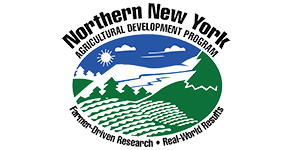 Funding for the Northern New York Agricultural Development Program is supported by the New York State Legislature and administrated by the New York State Department of Agriculture and Markets.
Funding for the Northern New York Agricultural Development Program is supported by the New York State Legislature and administrated by the New York State Department of Agriculture and Markets.
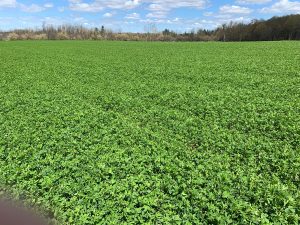 June 15, 2021. Cornell University Entomologist Elson Shields, Ph.D., shared this May 2021 photo of a lush alfalfa field in North Bangor (Franklin County), New York, with a note that prior to an application of biocontrol nematodes four years ago this field could grow nothing more than grass hay. It has now been restored to a substantial contribution to the farm’s cropping plan. Long-term support from the Northern New York Agricultural Development Program made possible Shields’ research to develop the science needed to find a nature-based solution for managing the #1 destructive pest of alfalfa crops, alfalfa snout beetle. That solution is now working in multiple states to combat different crop and berry pests. Photo: Elson Shields
June 15, 2021. Cornell University Entomologist Elson Shields, Ph.D., shared this May 2021 photo of a lush alfalfa field in North Bangor (Franklin County), New York, with a note that prior to an application of biocontrol nematodes four years ago this field could grow nothing more than grass hay. It has now been restored to a substantial contribution to the farm’s cropping plan. Long-term support from the Northern New York Agricultural Development Program made possible Shields’ research to develop the science needed to find a nature-based solution for managing the #1 destructive pest of alfalfa crops, alfalfa snout beetle. That solution is now working in multiple states to combat different crop and berry pests. Photo: Elson Shields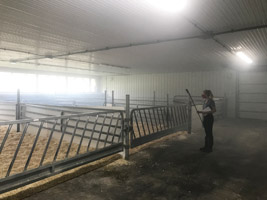
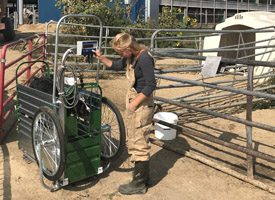
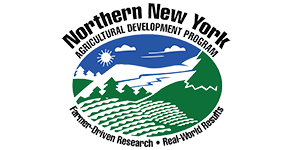 Funding for the Northern New York Agricultural Development Program is supported by the New York State Legislature and administered by the New York State Department of Agriculture and Markets.
Funding for the Northern New York Agricultural Development Program is supported by the New York State Legislature and administered by the New York State Department of Agriculture and Markets.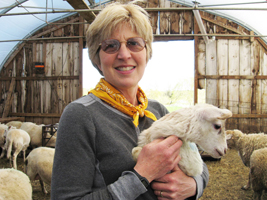
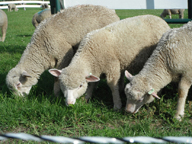 Photo, left: Cornell Cooperative Extension (CCE) livestock specialist Betsy Hodge leads the 2021 NNYADP project evaluating indoor-outdoor summer feeding options to enhance lamb health. Photo, right: The CCE St. Lawrence County Extension Learning Farm in Canton, New York, is hosting Northern New York Agricultural Development Program-funded research evaluating indoor-outdoor summer feeding options for lambs. Photo courtesy of Betsy Hodge.
Photo, left: Cornell Cooperative Extension (CCE) livestock specialist Betsy Hodge leads the 2021 NNYADP project evaluating indoor-outdoor summer feeding options to enhance lamb health. Photo, right: The CCE St. Lawrence County Extension Learning Farm in Canton, New York, is hosting Northern New York Agricultural Development Program-funded research evaluating indoor-outdoor summer feeding options for lambs. Photo courtesy of Betsy Hodge.